Total Comp Statement Mail Merge Tutorial using Microsoft 365 Word and Excel
A comprehensive step-by-step guide for creating total compensation statements using mail merge in Microsoft Word and Excel in 2024.
PROCESS AND BEST PRACTICESTOTAL COMPENSATION STATEMENTSQUALITY ASSURANCE
Liza Penney
7/17/202410 min read
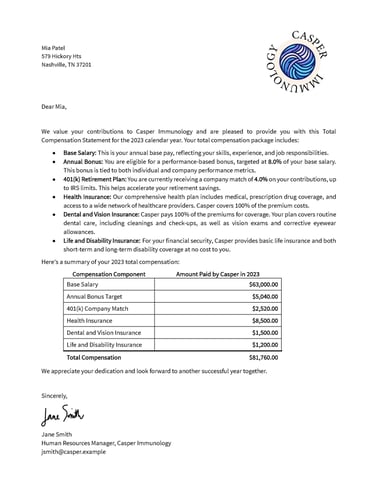
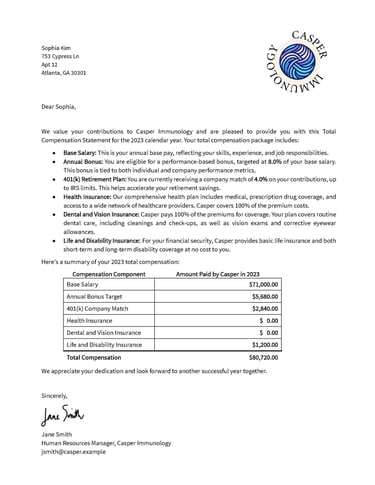
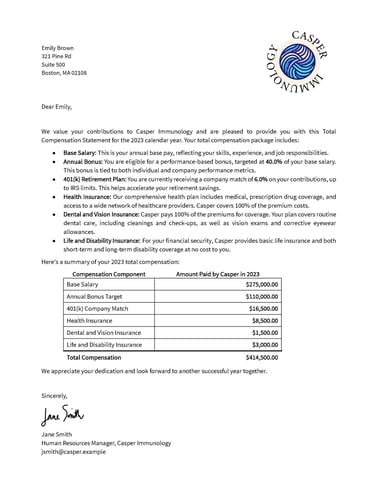
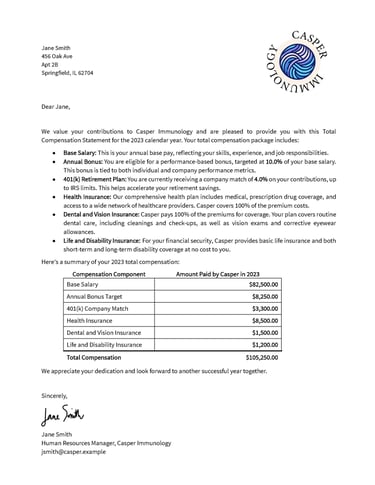
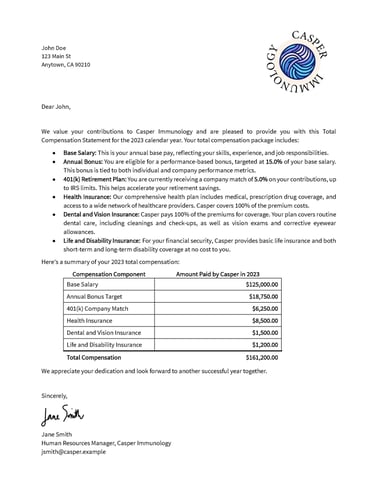





example total compensation statements built with Excel and Word Mail Merge - click each image for a full-sized view
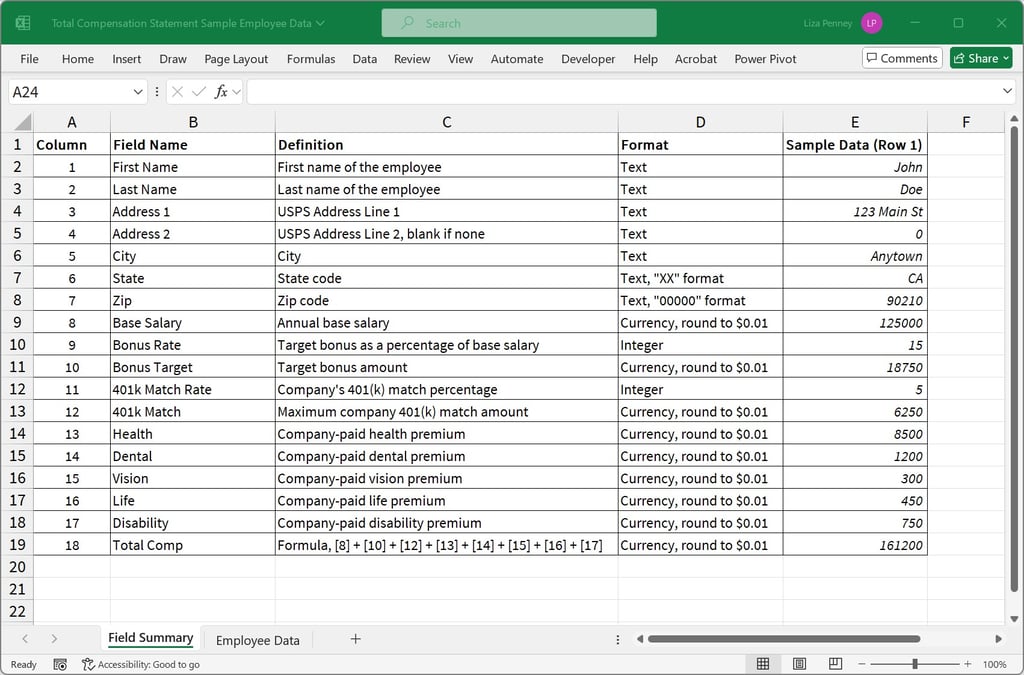

data field summary for total compensation mail merge project with mock employee sample data shown
Are you looking to create professional, personalized total compensation statements for your employees? Do you want to save time, reduce errors, and streamline the process? In this step-by-step tutorial, we'll show you how to use mail merge in Microsoft Word and Excel to generate custom total comp statements efficiently.
Total compensation statements are powerful tools for communicating the full value of an employee's compensation package, beyond just their base salary. By providing a comprehensive breakdown of base pay, bonuses, benefits, and other rewards, these statements help employees understand and appreciate the investment your organization is making in them. However, creating personalized statements for each employee can be time-consuming and prone to errors when done manually. That's where mail merge comes in.
What is a Total Compensation Statement?
Total compensation statements are documents that provide employees with a detailed overview of their complete compensation package. These statements typically include:
Base salary or hourly wage
Bonuses, incentives, and commissions
Health, dental, and vision insurance
Retirement plans, such as 401(k) or pension contributions
Stock options or equity grants
Paid time off, including vacation, sick days, and holidays
Other perks and benefits, such as tuition reimbursement or wellness programs
By presenting all these elements in a single, personalized statement, you can help employees understand the true value of their compensation beyond just their paycheck. This transparency can lead to increased job satisfaction, loyalty, and motivation. Statements can be distributed digitally as personalized individual PDFs or printed and mailed to employee homes or shipped to office locations.
Why Use Mail Merge for Total Comp Statements?
Mail merge is a feature in Microsoft Word that allows you to create personalized documents by combining a main template with a data source, such as an Excel spreadsheet. This is particularly useful for total comp statements, as it enables you to:
Automate the process of generating statements for each employee, saving time and reducing manual effort
Ensure consistency and accuracy across all statements, as the data is pulled directly from your source file
Easily update and regenerate statements when compensation data changes, without having to manually edit each document
By using mail merge, you can streamline the creation of total comp statements, freeing up time for more strategic HR initiatives while still providing employees with valuable information about their compensation.
Step 1: Prepare Your Employee Data in Excel
To begin, you'll need to organize your employee compensation data in an Excel spreadsheet. Here's how:
Open a new Excel workbook and create a sheet named Employee Data or similar.
Consider adding a unique identifier to the first column, such as employee ID number or Social Security number, that will help you to consolidate data but won't be visible to employees on the total compensation statements.
In the first row, create headers for each data point you want to include in your total comp statements. For example:
First Name
Base Salary
Bonus Amount
Health Insurance
Retirement Contribution
Total Compensation
Fill in the data for each employee, ensuring that all values are formatted consistently and accurately. If you included a unique identifier in the first column, you can write conditional VLOOKUP formulas to pull data from multiple sources into your Employee Data sheet. Write formulas for any calculations, such as the sum of each type of compensation for the «Total Comp» field.
Double-check your data for any errors, missing information, or inconsistencies.
Save your Excel file in a location you can easily access later.
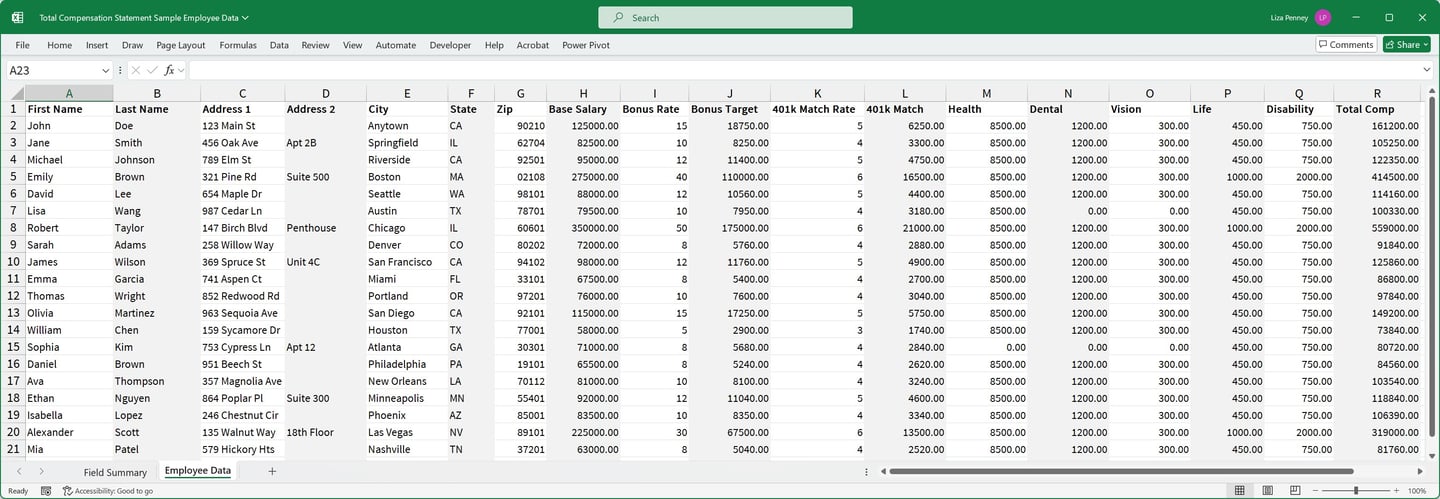

mock employee data for total compensation statement mail merge
Overcoming Data Complexity and Integration Challenges
Gathering, integrating, and preparing employee data can be a daunting task, especially when:
Dealing with multiple data sources (HRIS, payroll, benefits, etc.)
Inconsistent data formats and structures across systems
Ensuring data accuracy and completeness
Validating and transforming data for mail merge compatibility
If you find yourself spending hours wrangling data, questioning data integrity, or struggling to consolidate information, Atlas can help:
Seamlessly integrate data from disparate systems
Apply robust validation checks to ensure accuracy
Transform your data into a consistent, merge-ready format
Step 2: Design Your Total Comp Statement Template in Word
Next, you'll create a template for your total comp statements in Microsoft Word. Here's how:
Open a new Word document.
Design your template, including elements such as:
Company logo and branding
Employee identification and delivery section including address block, Employee ID and job title.
Compensation data headers and labels (e.g., "Your 2023 Base Salary", "Annual Bonus Amount")
Placeholders for personalized data (to be replaced with merge fields later)
Any necessary disclaimers or explanatory text. Consider writing a 100 word introduction memo from company leadership and a 50 word summary description of each plan.
Format your template to ensure readability and visual appeal.
Save your template in a location you can easily access later.
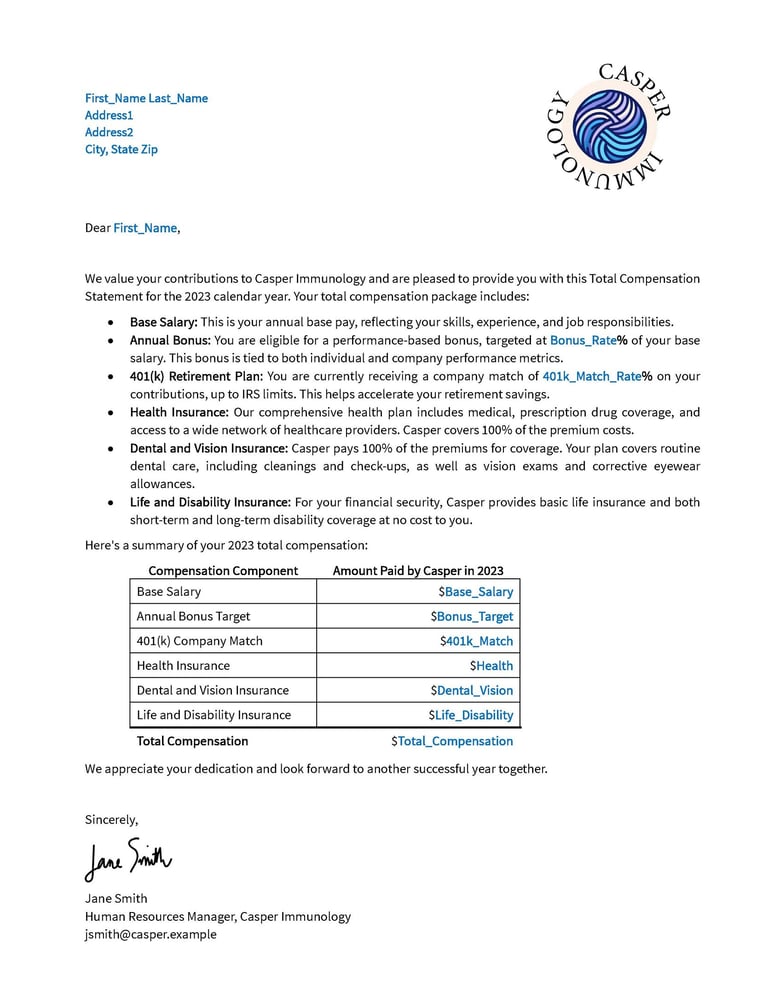

model total compensation statement with placeholders for mail merge fields in blue
Crafting Engaging, Compliant Templates
Designing a total comp statement template can be challenging when:
Balancing visual appeal with information clarity
Ensuring brand consistency and legal compliance
Accommodating different compensation components and scenarios
Iterating on designs based on stakeholder feedback
If you lack the design skills, time, or resources to create a professional, compliant template, Atlas can help:
Create a custom template that aligns with your brand and legal requirements
Optimize layout and information hierarchy for clarity and impact
Incorporate best practices for total comp statement design
Build clear and compelling charts and graphics to tell personalized stories with your data
Step 3: Insert and Format Merge Fields
Next, you'll create a template for your total comp statements in Microsoft Word. Here's how:
Open your Word template and start programming your mail merge by linking to your data file. Use the "Select Recipients" option "Use an Existing List" to browse to your data file, identify the sheet or named range location of the data for your merge, and preview the selected data.
To insert a merge field:
Place your cursor where you want the personalized data to appear
Click on the "Insert Merge Field" button in the "Mailings" tab
Select the appropriate field name from the dropdown list (e.g., "First_Name")
Repeat step 2 for each piece of personalized data you want to include
Use the "Preview Results" option to see how the merged data will look
screenshot of Mailings ribbon with the Select Recipients option Use an Existing List selected
screenshot showing the Insert Merge Field dropdown list of available merge fields
detailed options in the Select Recipients wizard
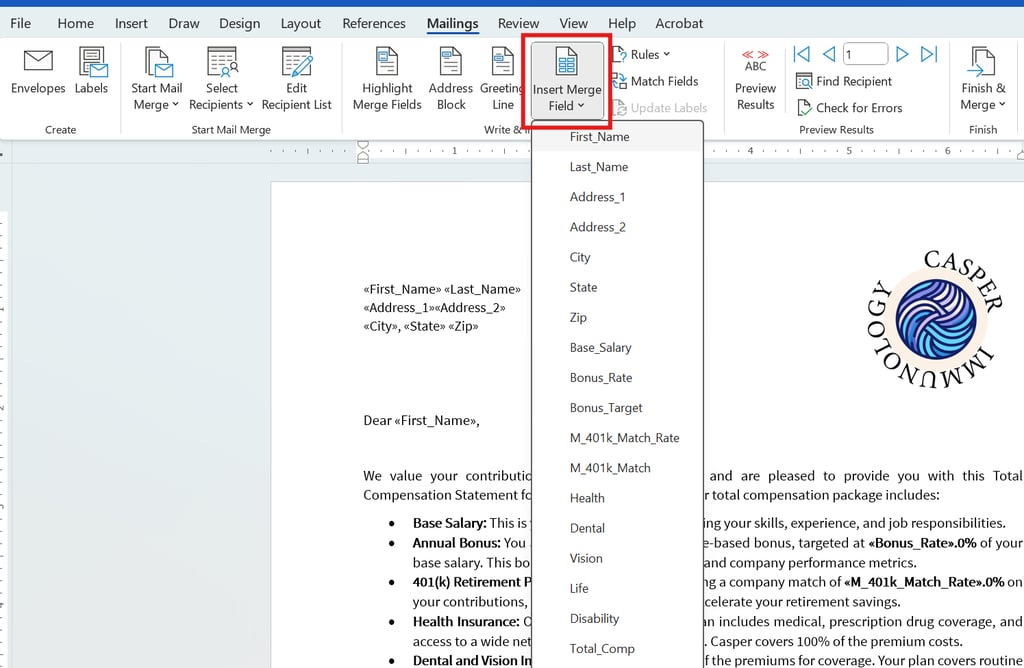



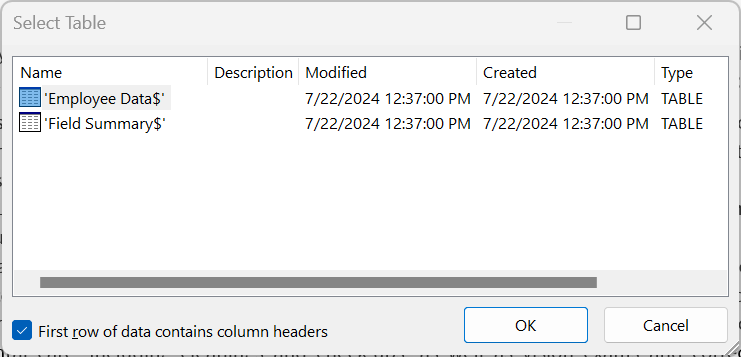

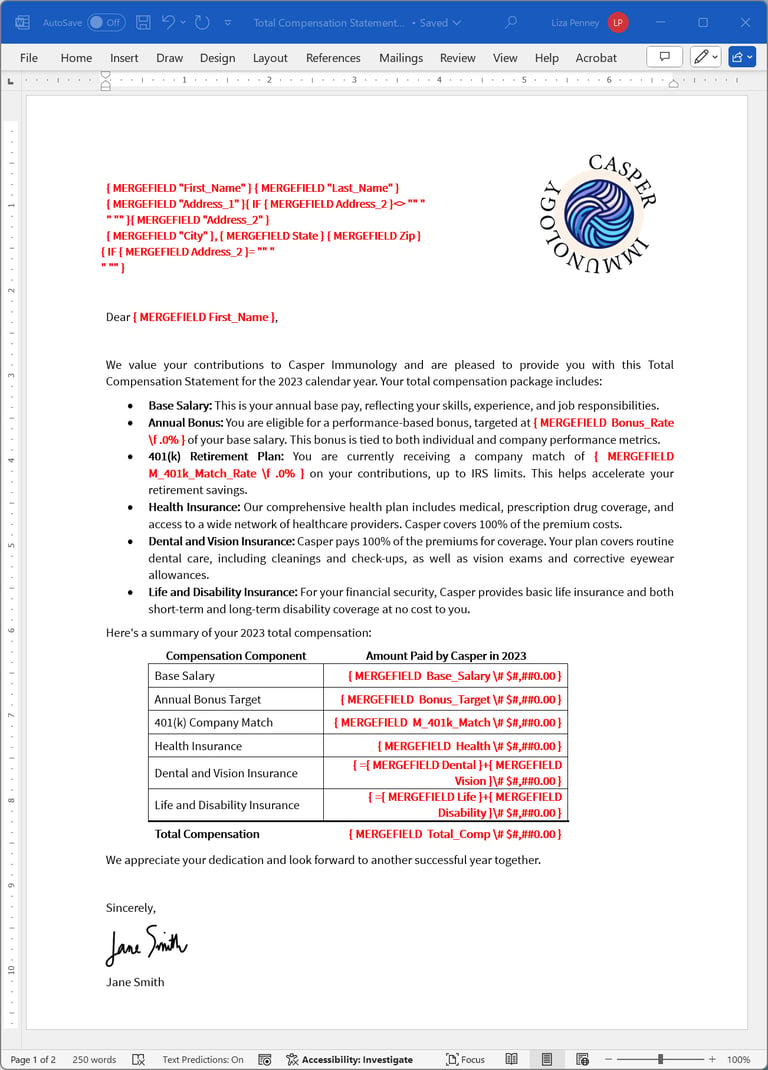

model total compensation statement with programmed mail merge field codes and switches in red
Simplifying Complex Merge Fields and Calculations
Inserting and formatting merge fields can become complex when:
Dealing with intricate compensation packages and scenarios
Applying conditional formatting or logic
Developing custom formulas and calculations
Troubleshooting field syntax and formatting issues
If you find yourself struggling with advanced merge field techniques or custom calculations, Atlas can help:
Develop merge field solutions tailored to your unique requirements
Implement accurate, reliable formulas and calculations
Keep you organized with variable text and merge field documentation
Ensure merge fields are properly formatted and styled
Step 4: Preview and Test Your Mail Merge
Before generating your final total comp statements, it's crucial to preview and test your mail merge to ensure accuracy and catch any errors. Here's how:
In your Word template, click on the "Preview Results" button in the "Mailings" tab to see how your merged data will look.
Carefully review each field to ensure the correct data is being pulled from your Excel source file.
Check for any formatting issues, such as text wrapping or misaligned elements.
If you spot any errors, go back to your Excel file or Word template and make the necessary adjustments.
Once you're satisfied with the preview, proceed to the next step.

screenshot of Mailings ribbon with the Preview Results button selected
Ensuring Accuracy and Consistency with Comprehensive Testing
Previewing and testing your mail merge is essential, but it can be time-consuming when:
Generating test statements for various employee scenarios
Coordinating reviews with multiple stakeholders
Identifying and resolving data inconsistencies or errors
Performing thorough QA checks for accuracy and compliance
If you're concerned about the effort required to ensure comprehensive testing and QA, Atlas can help:
Develop a rigorous testing plan tailored to your needs
Facilitate efficient stakeholder reviews and feedback loops
Perform detailed QA checks to ensure accuracy and consistency
Step 5: Generate and Distribute Your Total Comp Statements
In your Word template, click on the "Finish & Merge" button in the "Mailings" tab.
Select "Edit Individual Documents" to create a new Word document with all your merged statements.
Choose whether to merge all records or a specific range, then click "OK."
Review your merged document for any final tweaks or adjustments.
Save your merged document as a PDF with the "Print to PDF" file menu option to preserve formatting and ensure compatibility across devices.
Use PDF tools such as the Adobe Acrobat "Split" tool to divide the PDF of the full set of statements into an individual PDF for each record.
Distribute your PDF total comp statements to employees via email, secure portal, or printed copies, depending on your company's preferences and policies.
screenshot of Mailings ribbon with the Edit Individual Documents button selected


Streamlining Secure Distribution and Employee Engagement
Generating and distributing total comp statements can be complex when:
Ensuring data privacy and security throughout the process
Coordinating print and mail fulfillment for physical statements
Developing a secure digital distribution strategy
Creating engaging employee communications and resources
If you're looking to streamline distribution, enhance security, or improve employee engagement, Atlas can help:
Secure generation and distribution of physical and digital statements
Customized employee communication templates and talking points
Best practices for presenting and discussing total comp statements
Bonus: Advanced Mail Merge Techniques
For the beginning to intermediate user, we recommend making any modifications to your data, such as formatting changes or applying calculations, in Excel. You can then proceed with the basic mail merge steps above with your modified data. For the advanced user, you can make formatting and calculated changes directly in your Word template using the "Insert Field" menu.
Accessing the "Insert Field" Menu
In your Word template, click on the merge field you want to modify.
Click on the "Insert" tab in the Word ribbon.
Click on the "Field" button in the "Quick Parts" group.
Modifying Field Format
In the "Field" dialog box, select the desired format from the "Field names" list (e.g., "Numeric", "Date", "General").
Click on the "Field Codes" button to view and modify the field code.
Make any necessary formatting or logic-driven changes to the field code with mail merge switches:
Numeric Formatting Switches
# $#,##0.00: Formats a number as currency with two decimal places (e.g., $1,234.50)
# #,##0: Formats a number with comma separators (e.g., 1,234)
# #,##0.00%: Formats a number as a percentage with two decimal places (e.g., 12.34%)
Example: «MERGEFIELD Base_Salary # $#,##0.00»
Date Formatting Switches
@ "M/d/yyyy": Formats a date as "month/day/year" (e.g., 3/15/2023)
@ "MMMM d, yyyy": Formats a date as "full month name day, year" (e.g., March 15, 2023)
@ "d-MMM-yy": Formats a date as "day-abbreviated month-two-digit year" (e.g., 15-Mar-23)
Example: «MERGEFIELD Hire_Date @ "M/d/yyyy"»
Conditional Formatting Switches
* MERGEFORMAT: Preserves the formatting of the merge field in the template
* CHARFORMAT: Applies the character formatting of the merge field to the merged data
* CAPS: Converts the merged data to uppercase
* Lower: Converts the merged data to lowercase
* FirstCap: Capitalizes the first letter of each word in the merged data
Example: «MERGEFIELD Department * CAPS»
Click "OK" to apply the changes.
Unlocking the Full Potential of Mail Merge with Atlas
Advanced mail merge techniques can help you create more sophisticated total comp statements, but they often require:
In-depth knowledge of field code syntax and functions
Understanding of complex formulas and calculations
Familiarity with macro development and automation
Creativity in designing dynamic layouts and visualizations
If you want to push the boundaries of what's possible with mail merge, Atlas can help:
Develop custom charts and automated workflows
Implement advanced data validation and error-checking
Explore innovative ways to enhance the impact of your statements
Conclusion
Creating personalized total compensation statements for your employees is a powerful way to communicate the full value of their compensation package and drive engagement. By using mail merge in Microsoft Word and Excel, you can streamline the process, reduce errors, and save time compared to manually creating each statement.
In this tutorial, we've walked through the key steps to create total compensation statements using mail merge:
Preparing your employee data in Excel
Designing your statement template in Word
Inserting and formatting merge fields
Previewing and testing your mail merge
Generating and distributing your final statements
With practice and attention to detail, you can create professional, accurate, and compelling total comp statements that help your employees understand and appreciate the investment your organization is making in them.
If you encounter challenges along the way or want to explore more advanced mail merge techniques, remember that Atlas is here to help. We can provide guidance, support, and custom solutions to take your total comp statements to the next level.
Contact Liza
Custom employee statements for HR
